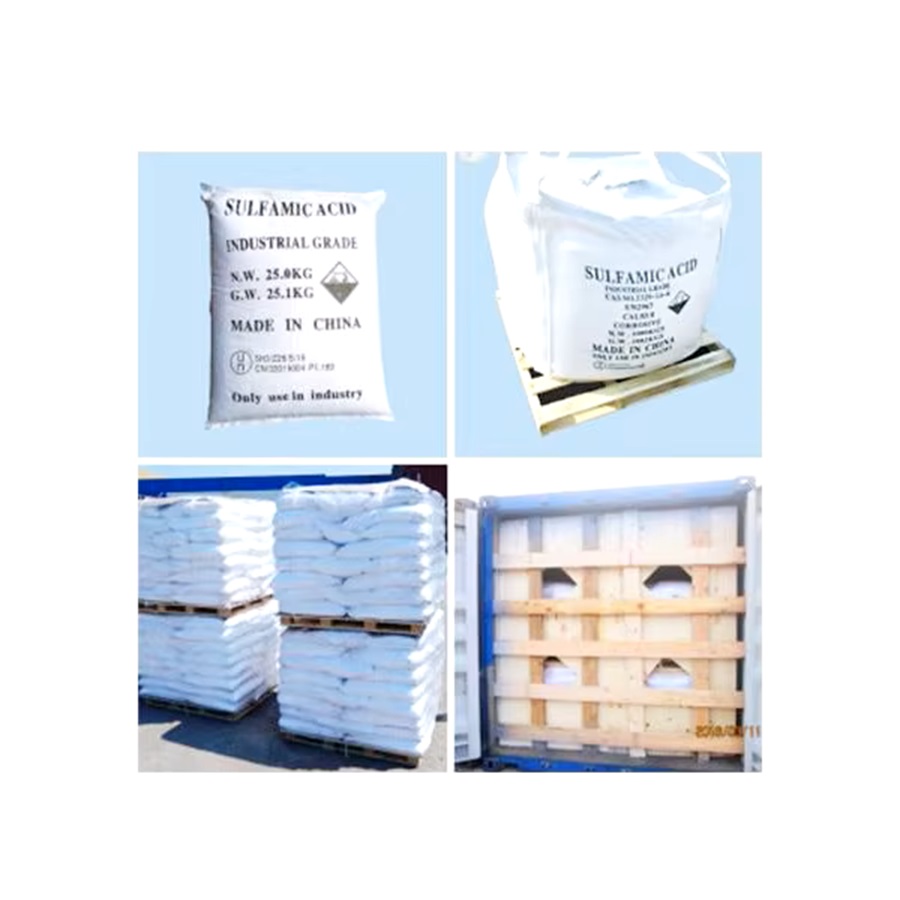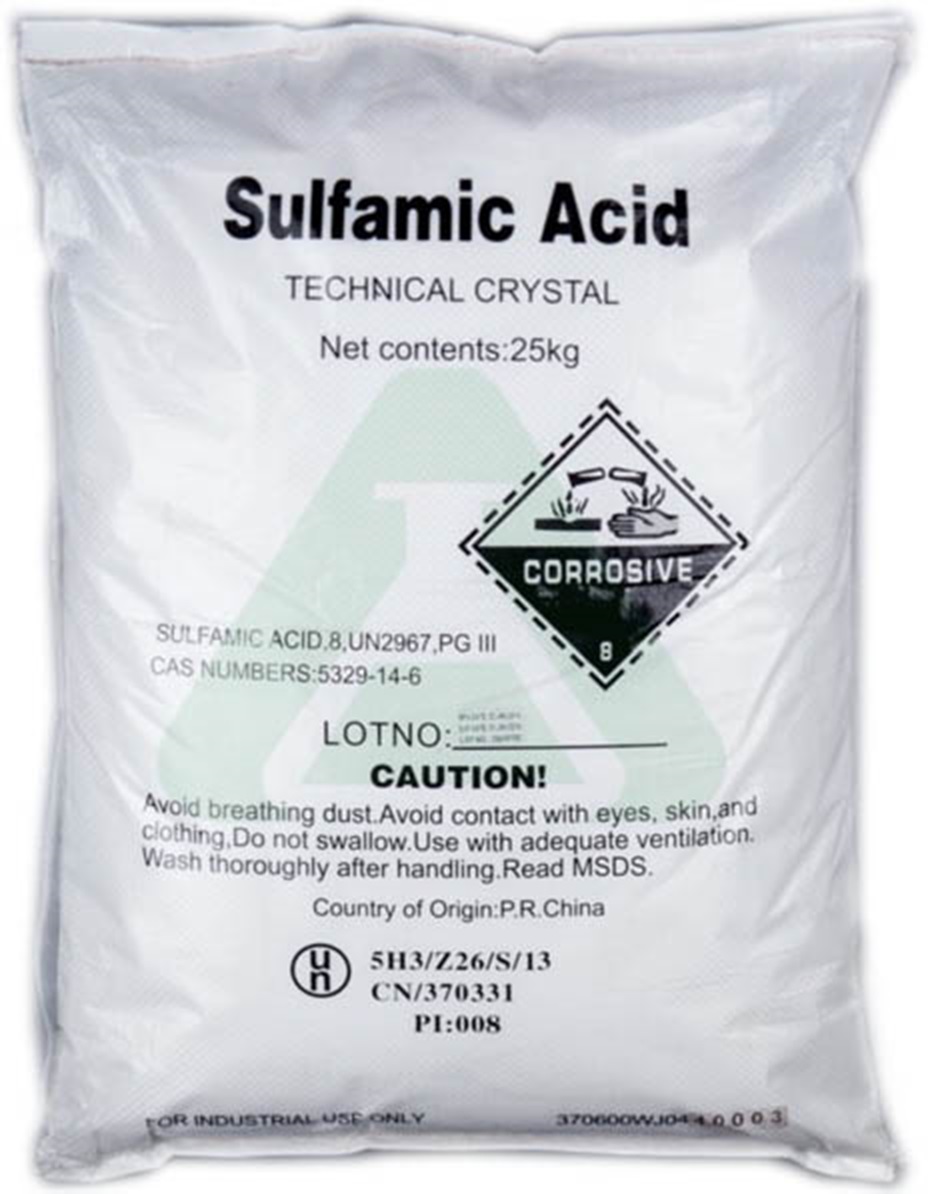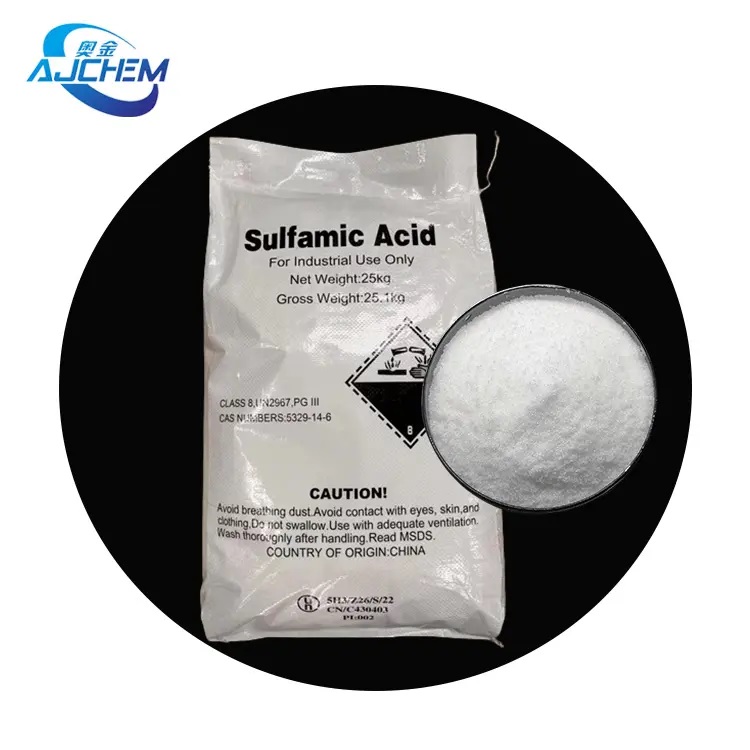Construction, Mining, Metal
Do you have questions?
We unleash your business potential by maximize the business innovation.
Send EmailSulfamic acid, Famic acid, Amino Sulfuric Acid, 5329-14-6
CAS: 5329-14-6
Molecular Formula: H3NO3S
Names and Identifiers
| Name | Sulfamic acid |
| Synonyms | Jumbo famic acid SULFAMIC ACID Sulfamic acid sulphamic acid SULFAMIDIC ACID aminosulfuricacid Amidosulfuric acid Imidosulfonic acid Amidosulfonic acid Aminosulfonic acid Kyselina sulfaminova Kyselina amidosulfonova |
| CAS | 5329-14-6 |
| EINECS | 226-218-8 |
| InChI | InChI=1/H3NO3S/c1-5(2,3)4/h(H3,1,2,3,4) |
| InChIKey | IIACRCGMVDHOTQ-UHFFFAOYSA-N |
Physico-chemical Properties
| Molecular Formula | H3NO3S |
| Molar Mass | 97.09 |
| Density | 2.151 g/cm3 at 25 °C |
| Melting Point | 215-225 °C (dec.) (lit.) |
| Boling Point | -520.47°C (estimate) |
| Water Solubility | 146.8 g/L (20 ºC) |
| Solubility | water: soluble213g/L at 20°C |
| Vapor Presure | 0.8Pa at 20℃ |
| Appearance | Crystals or Crystalline Powder |
| Color | White |
| Merck | 14,8921 |
| pKa | -8.53±0.27(Predicted) |
| PH | 1.2 (10g/l, H2O) |
| Storage Condition | Store below +30°C. |
| Stability | Stable. |
| Refractive Index | 1.553 |
| Physical and Chemical Properties | Melting point 215-225°C (dec.) water-soluble 146.8g/L (20°C) H2NSO2OH white orthorhombic crystals. Non-volatile, non-hygroscopic, density 2.126, melting point 205 ° C (begin to decompose). Soluble in water, slightly soluble or insoluble in organic solvents. It can be ionized in aqueous solution and is moderately acidic. Most of the metal salts are also soluble in water. Stable at room temperature. Decomposition at high temperature. |
| Use | For herbicides, fire retardants, paper and textile softeners, metal cleaning agents, etc |
Risk and Safety
| Hazard Symbols | Xi - Irritant |
| Risk Codes | R36/38 - Irritating to eyes and skin. R52/53 - Harmful to aquatic organisms, may cause long-term adverse effects in the aquatic environment. |
| Safety Description | S26 - In case of contact with eyes, rinse immediately with plenty of water and seek medical advice. S28 - After contact with skin, wash immediately with plenty of soap-suds. S61 - Avoid release to the environment. Refer to special instructions / safety data sheets. S28A - |
| UN IDs | UN 2967 8/PG 3 |
| WGK Germany | 1 |
| RTECS | WO5950000 |
| TSCA | Yes |
| HS Code | 28111980 |
| Hazard Class | 8 |
| Packing Group | III |
| Toxicity | MLD orally in rats: 1.6 g/kg (Ambrose) |
Upstream Downstream Industry
| Raw Materials | Urea Sulfuric acid Chlorosulfonic acid |
| Downstream Products | Cobalt sulfamate Nickel sulfamate Acid Green 20 Ammonium sulfamate |
Nature
colorless and tasteless crystals. d 2. 126; Boiling point 205 degrees C (beginning of decomposition). Non-volatile, non-hygroscopic, flammable. Soluble in water, slightly soluble in organic solvents. It can be hydrolyzed in an aqueous solution, and the aqueous solution of sulfamic acid has the same acidity as hydrochloric acid, sulfuric acid and the like. In a dry environment at room temperature, sulfamic acid is relatively stable, as long as it is kept not in contact with water, and the solid is not hygroscopic. It decomposes at a high temperature to release toxic gases such as oxides of nitrogen and sulfur. Amino sulfonic acid and its salts can form soluble salts with a variety of metal compounds.
Preparation Method
urea is reacted with fuming sulfuric acid or chlorosulfonic acid at 40-70 ° C., and the reaction product is crystallized by adding water, filtered and dried.
Use
catalysts for the synthesis of urea-formaldehyde resin. In the production of azo dyes used in wax removal agent, electrochemical polishing agent, asphalt emulsifier, etchant, dye medicine and pigment industry as sulfonating agent, high efficiency bleaching agent, flame retardant, softener, resin crosslinking accelerator, herbicide. It is used as a Reference Reagent for acid-base titration in analytical chemistry.
Safety
rat oral LDso:3160mg/kg. Inhalation of this product has a stimulating effect on the upper respiratory tract. Skin or eye contact is strongly irritating or causes burns. Oral Burns of the oral cavity and digestive tract. Staff should be protected. If the skin and eyes are touched, they should be immediately rinsed with plenty of flowing water. Store in a cool, ventilated warehouse. Keep away from fire and heat source. Protection from direct sunlight. It should be stored separately from oxidants and alkalis, and mixed storage is not required.
Reference Information
| LogP | 0 at 20℃ |
| non-toxic solid strong acid | sulfamic acid is a colorless, odorless and non-toxic solid strong acid. The aqueous solution has the same strong acid properties as hydrochloric acid and sulfuric acid, but the corrosiveness to metals is much lower than that of hydrochloric acid, etc., and the toxicity to human body is extremely small, but the skin cannot be contacted for a long time, more can't enter the eyes. Because of its strong acid properties, it is also called solid sulfuric acid, which can replace sulfuric acid to make extremely pure stable crystals at normal temperature. Its packaging, storage and transportation are very convenient. The solid sulfamic acid has good stability in a dry room temperature environment, does not absorb moisture, does not volatilize, is soluble in water, can ionize in aqueous solution, is moderately acidic, and can be used as an acid standard solution when alkali is tipped. Slightly soluble or insoluble in organic solvents, insoluble in ether, soluble in liquid nitrogen, ethanol, formamide, acetone. Because of its excellent properties, it is widely used in pickling agents, chlorine stabilizers, sulfonating agents, nitrants, disinfectants, flame retardants, herbicides, synthetic sweeteners and catalysts. Figure 1 is the structural formula of sulfamic acid. Aminosulfonic acid aqueous solution has a slow effect on the corrosion products of iron. Some sodium chloride can be added to make it slowly produce hydrochloric acid, thereby effectively dissolving iron scale, which is suitable for removing iron, steel, copper, stainless steel and other materials. Scale and corrosion products on the surface of equipment manufactured. Aminosulfonic acid aqueous solution is the only acid that can be used for cleaning the surface of galvanized metal. The temperature during cleaning is generally controlled at no more than 66 ℃ (to prevent the decomposition of aminosulfonic acid) and the concentration does not exceed 10%. The production process of sulfamic acid is simple, the reaction is easier to control, the raw materials and equipment are easier to solve, the wastewater is also easy to treat, and the by-products can be effectively used. |
| Chemical reaction | Aminosulfonic acid is a strong acid that can react with many basic compounds. Under normal pressure, it is heated to above the melting point (209 ℃) and starts to decompose, and continues to heat to above 260 ℃ to decompose into sulfur trioxide, sulfur dioxide, nitrogen, hydrogen and water. (1) Aminosulfonic acid can react with metals to form transparent crystalline salts. For example: 2H2NSO3H Zn → Zn(SO3NH2)2 H2. (2) can react with metal oxides, carbonates and hydroxides: 1,FeO 2HSO3NH2 → Fe(SO3NH2)2 H2O 2,CaCO3 2HSO3NH2 → Ca(SO3NH2)2 H2O CO2 3,Ni(OH)2 2HSO3NH2 → Ni(SO3NH2)2 H2O. (3) can react with nitrate or nitrite: 1,HNO3 HSO3NH2 → H2SO4 N2O H2O 2,HNO2 HSO3NH2 → H2SO4 N2 H2O. (4) can react with oxidants (such as potassium chlorate, hypochlorous acid, etc.): 1,KClO3 2HSO3NH2 → 2H2SO4 KCl N2 H2O 2,2HOCl HSO3NH2 → HSO3NCl2 2H2O. (5) can react with thionyl chloride: SOCl2 HSO3NH2 → H2NSO2Cl HCI SO2. (6) can react with iodine and alkali metal iodide: 2HSO3NH2 3CsI H2O → CsI3 Cs2SO4 (NH4)2SO4. (7) Can react with hydroxyl compounds (including phenol): C2H5OH HSO3NH2 → C2H5OSO2ONH4. (8) sulfamic acid can also react with amino compounds: C2H5NH2 HSO3NH2 → C2H5NH2SO3NH2. |
| use | sulfamic acid is an important fine chemical product, A variety of industrial equipment and civil cleaning agents widely used in the manufacture of metals and ceramics, petroleum treatment agents and cleaning agents, electroplating industrial agents, electrochemical polishing agents, asphalt emulsifiers, etchants, dyes, pharmaceuticals and pigments Industrial sulfonating agents, dyeing agents, high-efficiency bleaching agents, fibers, paper flame retardants, softeners, resin crosslinking accelerators, paper and textile softeners, herbicides, anti-wilt agents, acid titration in analytical chemistry in various fields such as reference reagents and standard analytical reagents. Calcium sulfamate is used to control wheat rust. Sulfamic acid is used as a cleaning agent, because it is a solid, it has many advantages such as convenient storage, transportation, and easy preparation. It is especially suitable for long-distance use. The sulfamic acid cleaning agent has a wide range of applications and can be used to clean boilers, condensers, heat exchangers, jackets and chemical pipelines. In the brewery, use it to remove the scale layer on the glass-lined storage tanks, pots, open beer coolers, and beer barrels; clean the evaporator of the enamel factory, and the equipment of the paper mill; in the air conditioning aspect, it can remove the cooling system, The rust and scale of the evaporation condenser; the sea wheel can use it to remove the algae and scale in the seawater evaporator (distillation equipment), heat exchanger and salt water heater; it can clean the scale of copper pots, radiators, tableware washing mechanisms, silverware, flush toilets, ceramic tiles, food and milk processing equipment; it can remove the protein deposited on the digester and the disinfection used in fresh meat, vegetables, and cheese processing plants. The sediment on the Lu. The U.S. Department of Agriculture allows sulfamic acid to be used as an acid cleaner in fresh meat, poultry, rabbits, and egg processing companies. Aminosulfonic acid can be used as a reference reagent for acid-base titration in analytical chemistry. It is also used as a herbicide, a fire retardant, a softener for paper and textiles, a shrink-proof, bleaching, and softener for fibers. The cleaning agent of metals and ceramics, the catalyst for the synthesis of urinary aldehyde resin, it is also used for the diazotization of dyes and the pickling of electroplating metals. sulfamic acid can be used as a bleaching aid, which can reduce or eliminate the catalytic effect of heavy metal ions in the bleaching liquid, so that the quality of the bleaching liquid can be guaranteed, and the oxidative degradation of metal ions on the fiber can be reduced. It can also prevent the peeling reaction of the fiber and improve the strength and whiteness of the pulp. When applying, be careful not to put it directly into the bleaching liquid, but to dissolve it with water before entering the bleaching liquid. sulfamic acid is a solid monobasic inorganic acid, can also be regarded as sulfuric acid amide, sulfonamide acid, amine sulfonic acid. It is a sulfuric acid monoamide compound. Because of its amino and sulfonic acid bifunctional groups, it can carry out various chemical reactions and is a very important fine chemical. Used as herbicides, fire retardants, metal and ceramic cleaners, paper and textile softeners and bleaching agents, catalysts for the synthesis of urea-formaldehyde resin, nitrile remover in the production of azo dyes, and chlorination in swimming pools And the stabilizer of bleach, etc. As a reference reagent for acid-base titration in analytical chemistry. |
| Preparation of sulfamic acid by urea method | Urea method was the first method used to prepare sulfamic acid in Germany in 1936. Urea and fuming sulfuric acid react to obtain crude sulfamic acid, which is separated from its crystallization and purified by recrystallization. Chemical reaction equation:(NH2)2CO SO3 H2SO4 → 2NH2SO3H CO2. Process description 1. add urea with a single dosage into the reaction kettle, slowly add the required amount of fuming sulfuric acid and stir, and pay attention to control the reaction temperature not to be higher than 80 ℃. Until the fuming sulfuric acid is added, the reaction solution is homogeneous, and the end of the reaction is when no carbon dioxide gas is released. 2. slowly move the reaction liquid into the crystallization tank containing the sodium sulfate aqueous solution and cooled by ice brine. after the reaction liquid is completely transferred, it is fully cooled to precipitate the crystallization. 3. After centrifugation, crude sulfamic acid is obtained. 4. add crude sulfamic acid to the dissolution tank, heat and stir at 80 ℃ with twice the amount of water to dissolve the crystallization. after all dissolution, transfer the solution into the crystallization tank, add appropriate amount of industrial ethanol, and cool to fully crystallize the product. after centrifugation, the crystallization is dried and sub-packed as the product. fig. 1 is a flow chart of the production process of sulfamic acid prepared by urea method. |
| sulfamate | Currently, the commonly used sulfamates are zinc sulfamate and ammonium sulfamate. The former molecular formula Zn(H2NSO3)2 · 4H2O, molecular weight 329.98, white crystal, soluble in water, insoluble in organic solvent, used for electroplating. The latter molecular formula NH4 · SO3 · NH2, molecular weight 114.12, colorless hygroscopic crystal or white powder, melting point 133 ℃, heating to 160 ℃ to decompose, soluble in water, slightly soluble in glycerin, ethylene glycol and formamide, used as analytical reagent, herbicide, fire retardant and preparation of electroplating solution, etc. In the ammonia leaching process of nickel sulfide ore, unstable ammonium thiosulfate is produced. The latter is oxidized to ammonium trisulfate. In ammonia solution, ammonium trisulfate is further oxidized to produce ammonium sulfamate according to the following formula: (NH4)2S3O6 2O2 4NH3 H2O → NH4 · SO3 · NH2 2(NH4)2SO4 this salt is harmful to the further extraction of nickel, so after ammonia is evaporated, it needs to be oxidized to convert it into ammonium sulfate, and then nickel powder is prepared by pressurized hydrogen reduction. |
| Production method | There are many production methods for sulfamic acid, including the hydroxylamine method with sulfur dioxide and hydroxylamine or acetone oxime as raw materials, sulfite or sulfate and liquid ammonia as raw materials Ammonization method, chlorosulfonation method with urea and chlorosulfonic acid as raw materials, fuming sulfuric acid method with urea as raw materials, sulfuric acid method with urea, sulfur trioxide and sulfuric acid as raw materials and fuming sulfuric acid method (also known as liquid phase method) and gas phase method in which liquid ammonia is gasified and sulfur trioxide reacts under gas phase conditions. At present, the industrial processes at home and abroad are fuming sulfuric acid method and ammoniation method of direct synthesis of sulfur trioxide and ammonia. Urea and fuming sulfuric acid are sulfonated at 40-70°C to produce crude sulfamic acid, and then water is added to crystallize to obtain the finished sulfamic acid. Raw material consumption quota: urea 2000kg/t, fuming sulfuric acid 1500kg/t. its synthesis methods mainly include gas phase method and liquid phase method. The gas phase method has harsh operating conditions and high requirements for equipment materials. There are many by-products, and amino acids are easy to adhere to the inner wall of the reactor and need to be cleaned frequently. High production costs. The advantage is that the product has high purity. At present, most manufacturers use the liquid phase method. The introduction is as follows: add excess fuming sulfuric acid into the reaction kettle, stir and cool to 20~40 ℃, and start to add sulfuric acid and urea mixed in proportion. After the feeding is finished, stir at about 20 ℃ for 8 h. Then gradually raise the temperature to 70~90 ℃, evaporate sulfur trioxide, cool and precipitate. After solid-liquid sharing, crude sulfamic acid is obtained, recrystallized with water, dehydrated and dried to obtain high-purity fine sulfamic acid. S the synthesis method sulfonates urea and fuming sulfuric acid at 40~70 ℃ to generate crude sulfamic acid, and then adds water to crystallize and separate to prepare sulfamic acid, its CO(NH2)2 S03 H2SO4 → 2H2NSO3H CO2 ↑ |
| category | corroded articles |
| toxicity classification | low toxicity |
| acute toxicity | oral-rat LD50: 3160 mg/kg; Oral-mouse LD50: 1312 mg/kg |
| stimulation data | skin-rabbit 500 mg/24 hours severe; Eye-rabbit 0.25 mg/24 hours severe |
| flammability hazard characteristics | sulfuric acid released from water |
| storage and transportation characteristics | warehouse ventilation and low temperature drying; Store separately from alkali and oxidant |
| fire extinguishing agent | water |


